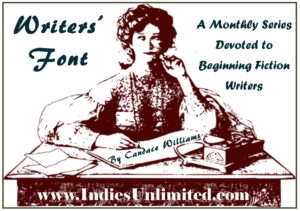 In last month’s Writers’ Font I said two essential elements in fiction writing are point-of-view (POV) and show vs. tell. With a level of mastery of these two elements of Craft, your writing will become more focused, clear, and exciting to read.
In last month’s Writers’ Font I said two essential elements in fiction writing are point-of-view (POV) and show vs. tell. With a level of mastery of these two elements of Craft, your writing will become more focused, clear, and exciting to read.
Let’s delve into POV first because you’ll save time and aggravation if you first decide which POV best fits the story. It can be confusing in the beginning if you’re not familiar with this part of the Craft. Just keep in mind that once you get it, it’s got. So, read on and don’t worry.
The POVs commonly used in writing fiction are: First Person, Third Person Limited, and Third Person Omniscient.  In First Person POV, the story is told from one person’s viewpoint, and that person narrates everything that happens. An example would be the character named Ishmael in Moby Dick, who begins the novel with the famous words, “Call me Ishmael.” Its pronouns are I, me, and mine.
In First Person POV, the story is told from one person’s viewpoint, and that person narrates everything that happens. An example would be the character named Ishmael in Moby Dick, who begins the novel with the famous words, “Call me Ishmael.” Its pronouns are I, me, and mine.
When using Third Person Limited, the story is told by an outside narrator (you, the author) from the viewpoint of the Main Character (MC). Harry Potter, the MC of the Harry Potter series, is an example of Third Person Limited POV. Its pronouns are he, she, it, and they.
This is the critical point to remember: in both cases – First Person and Third Person Limited – nothing can be shown to the reader unless the viewpoint character (e.g., Ishmael, Harry Potter) sees, hears, feels, smells, or tastes it. Also in both cases, the thoughts and motivations of the viewpoint character may be revealed to the reader.
For example, we can only know what Captain Ahab’s last words to Moby Dick were because Ishmael was there to hear them. “…to the last I grapple with thee; from hell’s heart I stab at thee; for hate’s sake, I spit my last breath at thee.”
If Ishmael had been below decks at the time, the only way we (the readers) could know about Ahab’s last words would be if someone told Ishmael what they heard the Captain say. Then Ishmael could narrate that to us, perhaps in this way: “It was then I learned from my shipmate what our captain uttered to the white whale: “…to the last I grapple with thee;” and so on.
For Third Person Omniscient POV, the outside narrator (you, the author) may tell the story from the viewpoint of the MC; also, you can make the thoughts and motivations of any or all other characters known to the reader.  There are two things we need in our quest for success: knowledge and confidence. Remember, confidence flows from knowing how to write. That’s true for whatever our dream is, whether it’s writing or something else. The most important thing we can do to achieve both confidence and knowledge is practice. Last month we looked at writing Flash Fiction and FanFic as ways for you to practice your knowledge of the Craft. Have you tried either of those yet? A third suggested way was to begin (or continue) journaling to get into the habit of writing every day. In addition, I highly recommend that you add a study of this comprehensive IU article on POV.
There are two things we need in our quest for success: knowledge and confidence. Remember, confidence flows from knowing how to write. That’s true for whatever our dream is, whether it’s writing or something else. The most important thing we can do to achieve both confidence and knowledge is practice. Last month we looked at writing Flash Fiction and FanFic as ways for you to practice your knowledge of the Craft. Have you tried either of those yet? A third suggested way was to begin (or continue) journaling to get into the habit of writing every day. In addition, I highly recommend that you add a study of this comprehensive IU article on POV.
Next month we’ll look at POV issues such as head-hopping, transitioning between POVs, and finding accidental POV slip-ups.

POV is one of the trickiest things to learn as a writer. I’m forever asking myself whose head I’m in and can the person know this. It’s obviously more complex than that, as you so aptly point out, but it’s a good editing gambit, or at least it is for me.
I’m forever asking myself whose head I’m in even when I’m not writing. LOL
As Gollum would say, “It’s tricksy!” 🙂
It’s easy to slip out of POV, but as you know, mastering the tricksy bits makes for better fiction writing.
Preciousssssssss. 😉
All that glitters is not gold. 🙂
Excellent breakdown of POV. I had never thought too much of the difference between third person limited and third person omniscient, but it makes a huge difference. Thanks for clarifying!
You’re all trisksters to me!
LOL Melanie! If it’s done right, it will seem magical, but it’s really just a matter of practice. Lots of practice…
Glad it was clear!
Getting the POV right can mean the difference between keeping the reader in the story, or giving the reader an uneasy feeling that something just isn’t right, or even dumping the reader outside the story altogether.
Melissa, I actually replied to this as a separate comment, below. Sigh.
Good breakdown of POV. I tend to like third person limited or first person. Omniscient is good, but the head hopping can be irritating. I’m glad you totally disregarded second person. I ended up reading a children’s book (to my kids) that was written in second person, and it was really just an odd experience. And also probably why almost no one uses second person.
I can see how a children’s book could work in second person if the MC is speaking directly to the child, but most often it’s found in nonfiction. I prefer third person limited, too. First person is daunting, at least to me. 🙂